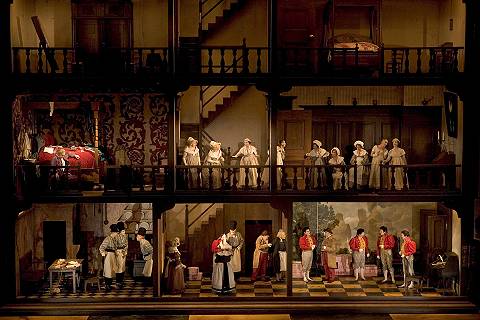|
<< -- 2 -- Robert Hugill CONFINED TO THE HOUSE

For the first two acts there are never more than eight people on stage, so this is not the reason why the staging feels so distracting. But a comparison with David Pountney's production of Greek Passion, recently revived at Covent Garden, is illuminating. Pountney also fills the stage top to bottom with an entire community (a complete village), but he uses the stage revolve and changes in lighting to ensure that the singers receive our maximum attention and that they are not undermined by unnecessary distractions, thus allowing them to fill the theatrical space.
Miller makes no such concessions, the whole set is permanently illuminated in the same rather flat lighting so that even if there is no movement, we are constantly distracted from the singers by the eight other visually discordant rooms. This also means that the singers are never really able to fill the complete theatrical space, just the room that they occupy. This issue affects the singers' projection too and their communication with the audience. They can never come forward to the footlights but are confined to the house, even though in real life a child would naturally take the dolls out of the doll's house to play with them. As a result, singers are always at some distance from the audience and to ensure adequate projection, spend much of the time singing over the railings that protect the exposed cut away edge of the floor, hardly looking at the person they are supposed to be singing to. All this critically affects the way the singers were able to project character and make us sympathise with the people in the opera.
Donizetti used a rather crude existing libretto for his comedy, but it has remained in the repertoire because he makes us care for these characters using a strong vein of sentiment that runs through his music. Initially we feel for Ernesto when he thinks that he has lost Norina, but gradually we feel sorry for Pasquale even though he is a buffoon. At the first performance Donizetti wanted this realism to be emphasised by having the characters dressed in contemporary nineteenth century costumes. All of Miller's innovations -- the doll's house; the eighteenth century setting; the distancing of singers from the audience -- have the effect of minimising the dramatic effect of Donizetti's music, making it harder for us to care for these people. Don Pasquale is not a slapstick farce, it is a comedy of character and relies on the audience observing the detailed interplay between the singers.

A scene from Act III of Jonathan Miller's production of 'Don Pasquale' at Covent Garden in London, showing a full stage image. Photo © 2004 Bill Cooper
|
To make his conception work, Miller has to make one significant change to the plot. When the curtain goes up, we see Ernesto and Norina in bed in Ernesto's room before they disappear upstairs into the attic, Norina wearing only her underwear. Later when the libretto calls for Norina to be seated in her own house, reading, waiting for Dr Malatesta, she is simply sitting in Ernesto's room and to visit her, all Malatesta has to do is go upstairs. Thus, Miller adds another artificial layer to what is already a rather artificial plot. We have to believe that Pasquale marries Norina and does not recognise her here, even though she has been wandering round his house in her underwear.
Continue >>
Copyright © 16 December 2004
Robert Hugill, London UK

|

